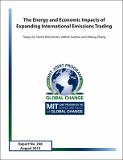| dc.contributor.author | Qi, Tianyu | |
| dc.contributor.author | Winchester, Niven | |
| dc.contributor.author | Karplus, Valerie | |
| dc.contributor.author | Zhang, Xiliang | |
| dc.date.accessioned | 2013-08-22T16:31:24Z | |
| dc.date.available | 2013-08-22T16:31:24Z | |
| dc.date.issued | 2013-08-21 | |
| dc.identifier.uri | http://hdl.handle.net/1721.1/79920 | |
| dc.description.abstract | Emissions trading systems are recognized as a cost-effective way to facilitate emissions abatement and are expected to play an important role in international cooperation for global climate mitigation. Starting from the planned linkage of the European Union’s Emissions Trading System with a new system in Australia in 2015, this paper simulates the impacts of expanding this international emissions market to include China and the US, which are respectively the largest and second largest carbon dioxide (CO2) emitters in the world. We find that including China and the US significantly impacts the price and the quantity of permits traded internationally. China exports emissions rights while other regions import permits. When China joins the EU-Australia/New Zealand (EU-ANZ) linked market, we find that the prevailing global carbon market price falls significantly, from $33 per ton of carbon dioxide (tCO2) to $11.2/tCO2. By contrast, adding the US to the EU-ANZ market increases the price to $46.1/tCO2. If both China and the US join the linked market, the market price of an emissions permit is $17.5/tCO2 and 608 million metric tons (mmt) are traded, compared to 93 mmt in the EU-ANZ scenario. The US and Australia would transfer, respectively, 55% and 78% of their domestic reduction burden to China (and a small amount to the EU) in return for a total transfer payment of $10.6 billion. International trading of emissions permits also leads to a redistribution of renewable energy production. When permit trading between all regions is considered, relative to when all carbon markets operate in isolation, renewable energy in China expands by more than 20% and shrinks by 48% and 90% in, respectively, the US and Australia-New Zealand. In all scenarios, global emissions are reduced by around 5% relative to a case without climate policies. | en_US |
| dc.description.sponsorship | The authors are grateful for the support provided by the National Key Technology R&D Program
from Ministry of Science and Technology of Grant NO. 2012BAC20B07. We acknowledge the
support of the National Key Technology R&D Program and the Institute for Energy,
Environment, and Economy at Tsinghua University, which is supporting Tianyu Qi’s doctoral
research as a visiting scholar at the Massachusetts Institute of Technology. We acknowledge the
support of ENI, ICF and Shell, initial Founding sponsors of the China Energy and Climate
Project. This consortium of sponsors has provided support for researchers in the MIT Joint
Program to engage in a five-year program of research focused on China. None of the sponsoring
organizations played a role in the study design, collection, analysis, or interpretation of the data
used for this study, nor did they influence our decisions to submit the article for publication, and
all errors are our own. | en_US |
| dc.language.iso | en_US | en_US |
| dc.publisher | MIT Joint Program | en_US |
| dc.relation.ispartofseries | MIT Joint Program Report Series;Report 248 | |
| dc.title | The Energy and Economic Impacts of Expanding International Emissions Trading | en_US |
| dc.type | Technical Report | en_US |
| dc.identifier.citation | Report 248 | en_US |
